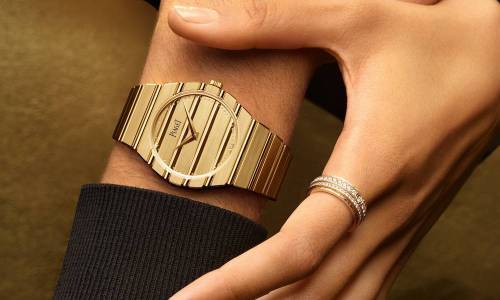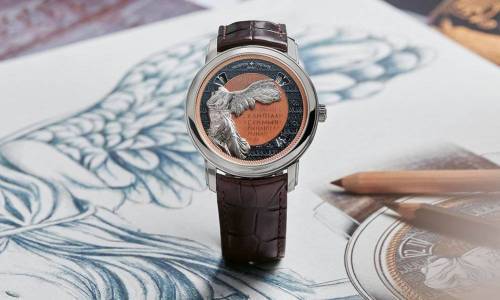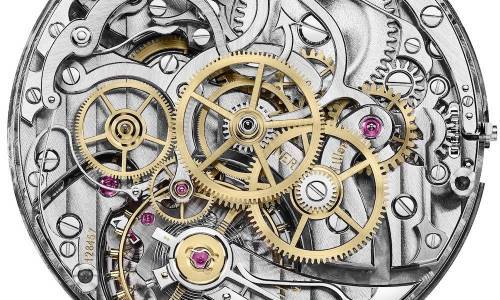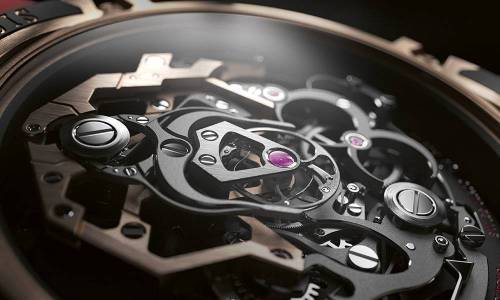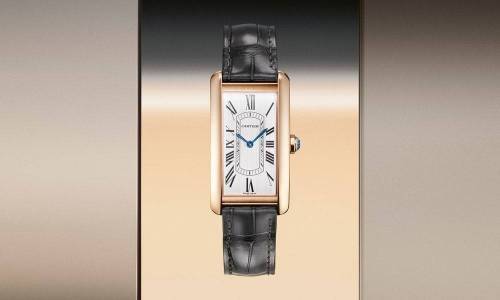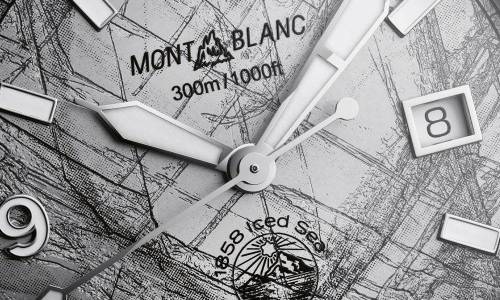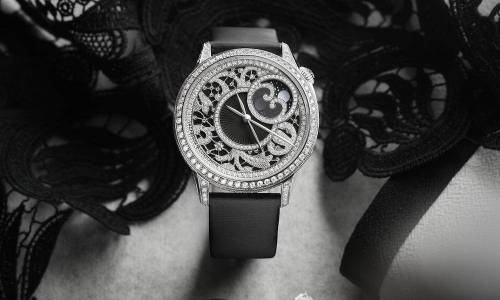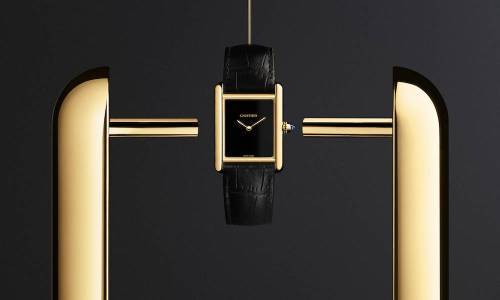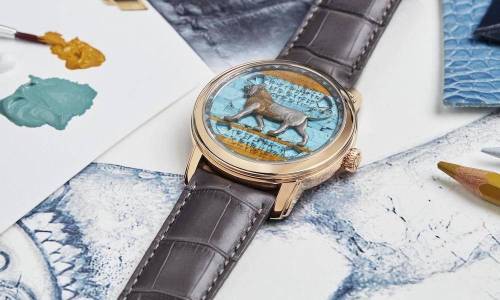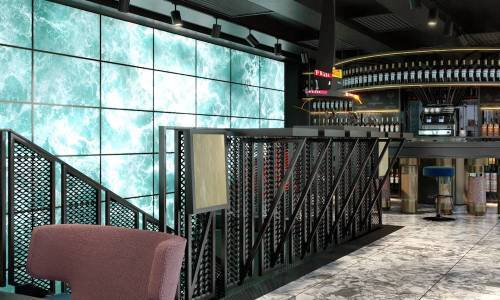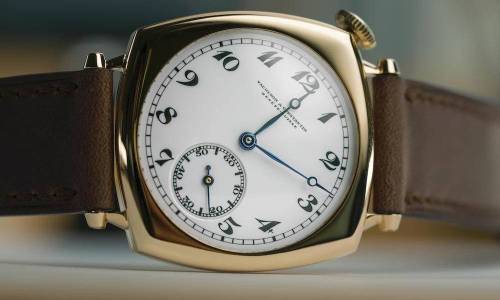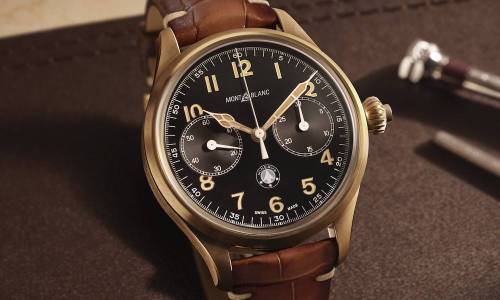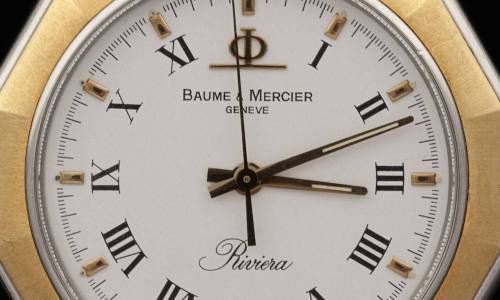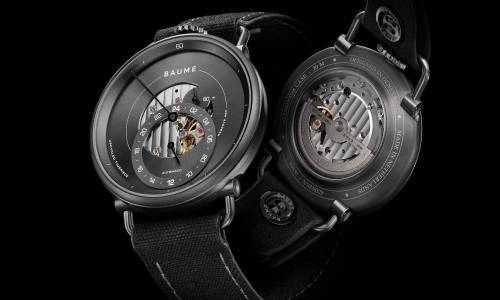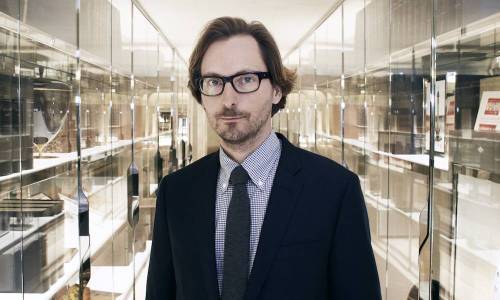anerai belongs to the very exclusive club of brands whose silhouette is recognisable from several yards away. A strong identity... and therefore strong constraints, which the Maison deliberately “owns” as a form of creative discipline. No oval or rectangular cases, no diamonds, no gratuitous effects: military-inspired watches, designed as instruments, born of the sea and for the sea.
It is within these well-defined parameters that Panerai explores new alloys, pushes the limits of luminescence, rethinks its industrial capabilities and introduces artificial intelligence into the heart of its Manufacture. The year 2025 also marks an important milestone for the Luminor collection – spearheaded by the new Luminor Marina – which the brand is more than ever positioning as the very emblem of its identity.
-

- Panerai on the cover of Europa Star in 1999
- ©Archives Europa Star
How can this technical proliferation be articulated through a clear message for the public? How can one create a dialogue between ultra-knowledgeable Paneristi (as brand enthusiasts are known) and newcomers attracted by these objects’ Italian design and raw power? More on these and other topics in this joint interview with Jérôme Cavadini and Alessandro Ficarelli.
Europa Star: What are the main areas of innovation you are currently working on – whether in terms of materials such as Platinumtech™, luminescence, water resistance or power reserve?
Jérôme Cavadini: Paradoxically, we have an infinite playground... within a very limited perimeter. We operate within self-imposed limits and are committed to respecting them: staying within the marine world, remaining true to our case shapes, which means no rectangular or oval watches, as well as avoiding decorating them with diamonds. This may seem restrictive, yet it is precisely what gives Panerai its consistency.
Based on that, our motto is very simple: it must be useful. No gimmicks, no accessory functions. A Panerai watch must be easy to read and intuitive to set, even if the movement is complex. This lays down some concrete requirements: a user-friendly crown, an instantly recognisable dial, an appropriate power reserve as well as genuine – and not merely claimed – water resistance.
When it comes to materials, we don’t just make a “shopping list” with random picks from Mendeleev’s periodic table. It’s not about launching one alloy over another for the sake of novelty, but instead about understanding what really works well within our constraints of strength, lightness, durability, maintenance and comfort. This is the context for developments such as Platinumtech™ and other alloys that we will be introducing in the coming years.
In terms of luminescence, we have taken our collaboration with our partner RC Tritec on Super-LumiNova to new heights. We first worked on the X1, then on an improved version that we were the first to use – a real token of confidence. Their CEO told us: “You pushed us so hard with your performance requirements at two, four and eight hours that this development was partly born from that dialogue.” From our standpoint, that was not the end of the story: we want to go even further in how we produce, store and transmit light energy, while respecting the fact that our watches remain mechanical.
To give a concrete example, we are working on devices serving to “boost” luminescence for around 30 minutes at the wearer’s request via an activation button. This is a typically useful innovation in a real-world context – and one that we will continue to improve. The challenge in all areas is to combine loyalty to our core characteristics, usefulness for the wearer and genuine technical progress.
-

- The Luminor Marina Militare PAM05218 revisits one of the most important milestones in the modern history of the Maison. Unveiled on 10 September 2025 at the opening of The Depths of Time exhibition, it pays tribute to the Luminor Marina Militare ref. 5218-202/A, which also made its debut in 1993, the same year as the Luminor ref. 5218-201/A and the Mare Nostrum ref. 5218-301/A.
2025 is the year of the Luminor, notably featuring new versions of the Marina in particular. What place does this collection hold within the brand’s overall strategy?
Alessandro Ficarelli: The Luminor Marina is much more than a collection: it’s embedded in Panerai’s DNA. When I joined the company in 2005, the Luminor was more famous than the brand itself! It is probably our most iconic watch. Even if the logo were to be removed, everything about it makes it instantly recognisable – from the cushion shape to the crown-guard device and the dial font.
Our goal today is to capitalise on this identity by making it even more relevant. Luminor is historically the emblem of the tool watch developed for the Italian Navy. That’s why, this year, we have chosen evolution rather than revolution: we are respecting the cushion shape and the codes that set us apart from the competition, while bringing them up to current standards.
Meanwhile, the Luminor Due has been trimmed down, Specifically, we have improved water resistance from 300 to 500 metres, bearing in mind that we always test our watches to around 25% above our stated specifications. We have further enhanced luminosity and shock resistance, while retaining a proven and reliable three-day automatic calibre. We have also worked on functional aesthetics: smoother integration of the lugs with the metal bracelet, a quic
We must preserve the legibility of a tool watch and its robustness characteristics, even when exploring smaller diameters. The challenge is not to go “ever smaller”, while remaining faithful to the brand’s inherent character.
-

- The 1956 Egiziano model
We must preserve the legibility of a tool watch and its robustness characteristics, even when exploring smaller diameters. The challenge is not to go “ever smaller”, while remaining faithful to the brand’s inherent character.
Jérôme Cavadini: While I have known several CEOs at Panerai, the desire to be credible has remained constant and credibility is based on truthfulness: we do what we say we will do. We are convinced that what we are putting in place is right and our responsibility is then to convince our customers, the press as well as our partners.
From the outset, we were told: “If you start talking high-tech, prove it.” Panerai is a paradise for engineers, with a manufacturing facility that reflects this reality. By way of example, we have several state-of-the-art micro-CNC workstations along with an investment plan that began with the machinery purchased in 2013. We also know that we must continue to develop in the future, particularly in the realm of bracelet links machined on multi-bar machines, a field where it remains difficult to improve on certain highly specialised solutions.

The benefits of micro-CNC machines are nonetheless very tangible: around 40% energy savings, approximately twice the efficiency per square metre, improved precision and more accessible programming languages. These machines are also more “intelligent”: they detect dimensional deviations, self-adjust and enable a fleet of around 20 machines to be managed by a small team of highly skilled technicians, without the need for three shifts or additional night or weekend teams.
Not everything is perfect: some machines are very compact, which entails limitations if you want to machine beyond 50 mm in diameter. We don’t yet have ten or 15 years of hindsight on the durability of these new generations compared to our former equipment, which we knew would need to be replaced after a decade. We are still in a proof of concept phase. mps et préserver en parallèle des réseaux de sourcing robustes.
Finally, inter-machine connectivity can still be improved. We can however already see the huge advantages as well as the limitations. The challenge is to maintain a balance: while we have worked hard on agility, we must not change everything all the time – and in parallel, it is imperative to to preserve robust sourcing networks.
This highly innovative environment can become extremely technical. How do you translate it into a marketing message that is understandable and appealing to a wide audience?
Alessandro Ficarelli: There is an interesting duality at Panerai. On the one hand, there are the Paneristi, who know the brand’s history by heart and follow every technical development. On the other hand, there is a wider audience drawn to the design, the Italian character and the presence on the wrist. Our role is to create a language that speaks to both.
The key is to start with history and heritage, even before technology. We have an exceptional and very specific history: that of a tool watch developed for the Italian Navy. If I start by telling that story and then explain the power reserve, the luminescence, the crown-guard device, the readability, the safety features... I’m simply showing that everything stems from performance. The technology becomes the modern translation of a historical need, rather than an abstract discourse.
We have also developed very concrete experiences with our customers, such as an expedition with Mike Horn or with the Italian Navy, or more “Dolce Vita” experiences centred on the beauty of Italy. Some limited editions are linked to these experiences, with access to places or activities not open to the public. The aim is to create lasting memories: we sell watches, of course, but also emotions and a sense of community.
Finally, our historic partnership with the Italian Navy – dating back to the early 20th century – and with the US Navy SEALs fuels a performance-based vision. This is what makes innovation credible in the eyes of longstanding devotees and newcomers alike.
-

- Panerai advertisement from 1999
- ©Archives Europa Star
Still on the subject of innovation, is the use of artificial intelligence already a daily reality in Panerai’s operations, or is it more of a long-term promise? In which areas is it most useful or promising?
Jérôme Cavadini:AI is changing everyone’s daily lives – including ours. But we need to make a distinction: at this stage, we do not use generative artificial intelligence to design our watches or write our messages; creation remains 100% human. On the other hand, AI is already omnipresent in engineering and simulation software.
Today, we can simulate very accurately a case’s resistance to pressure, the mechanical stresses on a case middle or lug, as well as the performance of a crown-guard system – even before any machining. We then produce a 3D print, make adjustments and return to the model. No one internally wants to “go back” to a time when everything had to be validated solely in physical form.
The same goes for forecasting. We have to model our sales based on factors such as the expansion of a network of shops, the number of points of sale and local specificities – such as the Indian calendar with festivals like Diwali, for example. We build business models for each shop and aggregate these calculations. Without these algorithms, we would probably need more people to do less high-quality work.
AI is also very present in maintenance prediction. We analyse large series of machining data and detect which tools are going to break before they do, which makes all the difference in production operations. All machine manufacturers are investing heavily in this predictability and we benefit directly from it.
Finally, we take advantage of this computing power while maintaining a degree of caution. While we have worked extensively on Industry 4.0 and agility, we have also decided not to constantly disrupt everything. We have agreed on a balance: multi-year roadmaps, a clear vision in terms of materials, movements and concepts. Together with our CEO Emmanuel Perrin, we have reviewed our movement bases and the functions we still want to explore.
Within a highly competitive watchmaking environment – in terms of heritage, design and innovation – what do you see as the main motivations that draw the public to Panerai? What are your key arguments?
Alessandro Ficarelli: I believe that Panerai has a set of characteristics that, taken together, are truly unique. It always comes back to history, but also to the way in which the design embodies that history. Wearing a Panerai is a kind of statement – of robustness, presence and self-confidence. There is a feeling of empowerment that the watch transmits to the wearer.
We enjoy very clear market differentiation because we don’t compromise. If we say we won’t make models that stray from our historical identity, we stick to it. This consistency ultimately creates very clear segmentation.
Our range is structured around four collections, including the Submersible, which became a collection in its own right in 2019, positioned as the pure diving watch; along with the Luminor, Radiomir and Luminor Due families. Innovation is also expressed through concepts such as LAB ID™ – where we explore highly advanced technological territories – but always in connection with our archives, such as with the Egiziano, the Mare Nostrum and many others. We have a wealth of archives enabling us to be innovative while remaining true to ourselves.
The right approach for us is not to launch a new collection every morning, nor to multiply shapes that are not in line with our codes. It is to work in depth on our existing cases, dials, functions and experiences. We want sustainable growth, not growth by volume at any cost. Panerai is a brand designed to last and that is also what our customers are looking for.





















